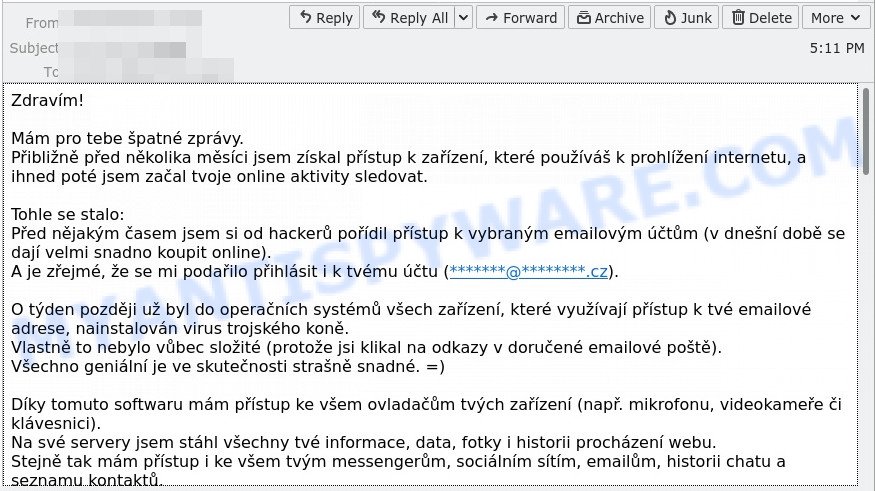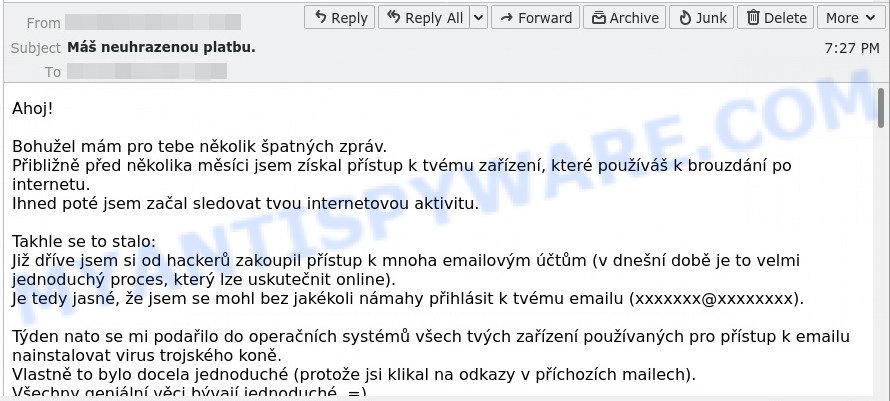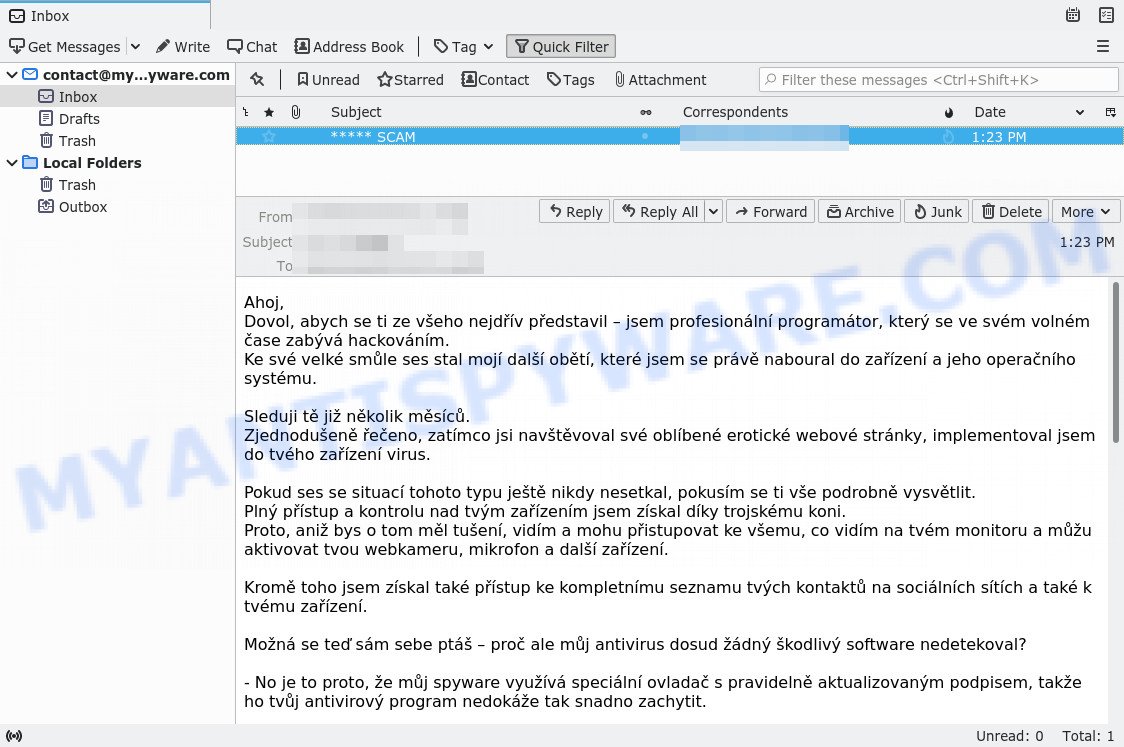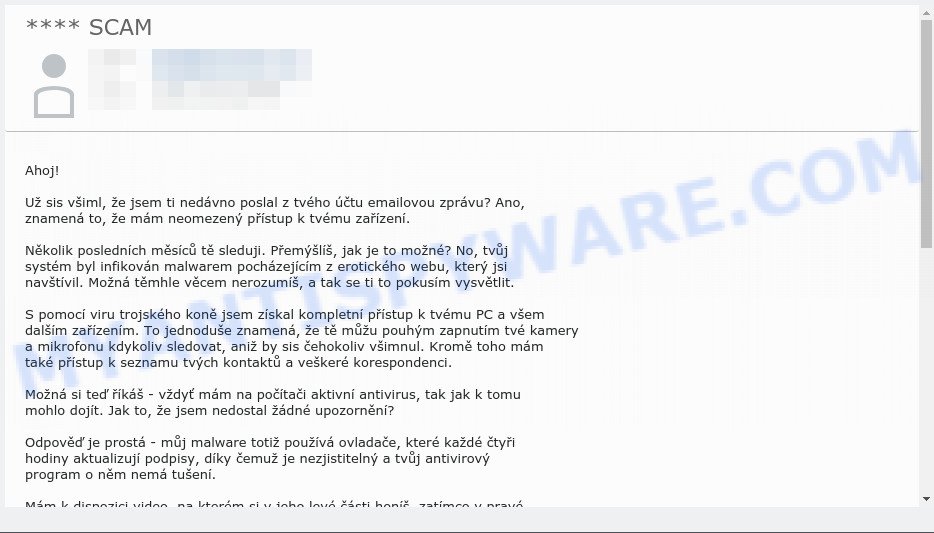What is “Bohužel mám pro tebe špatné zprávy” EMAIL?
Ahoj! Bohužel mám pro tebe špatné zprávy email is a variant of the sextortion scam. Sextortion email scams are targeting email accounts and convincing users they’ve been hacked. Sextortion scams claim that someone has installed malware onto the victim’s computer and they recorded the victim watching porn videos. They threaten to publicize that information if the victim doesn’t pay up — often through a bitcoin payment.
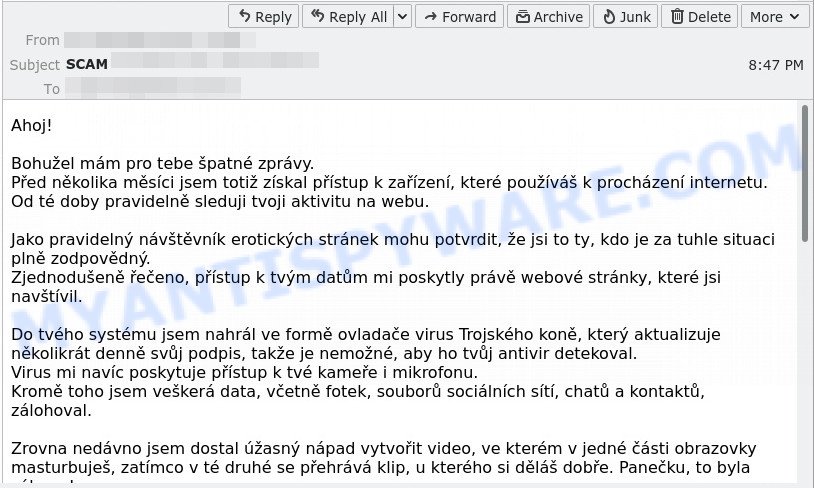
“Bohužel mám pro tebe špatné zprávy” email is a SCAM
QUICK LINKS
- What is “Bohužel mám pro tebe špatné zprávy” SCAM?
- What to do when you receive the scam message?
- How to spot a phishing email?
- Report Scam Email
The Scam in detail
The scam is a new sextortion scam that targets Czech language users. This scam is a new variant of the Unfortunately, there are some bad news for you Scam.
Scammers use email spam to promote this scam and create many new victims. Scammers slightly changed the original text and translated it into Czech, preserving the meaning of the text. The size of the ransom has also changed: now the scammers are demanding 39000 Kč from their victims. In addition, scammers are now using a new bitcoin wallet with the address 114vHR5SDqqX7DAtYcFe7hmCZD4Jsad3jH.
Text presented in the scam:
Ahoj!
Bohužel mám pro tebe špatné zprávy.
Před několika měsíci jsem totiž získal přístup k zařízení, které používáš k procházení internetu.
Od té doby pravidelně sleduji tvoji aktivitu na webu.Jako pravidelný návštěvník erotických stránek mohu potvrdit, že jsi to ty, kdo je za tuhle situaci plně zodpovědný.
Zjednodušeně řečeno, přístup k tvým datům mi poskytly právě webové stránky, které jsi navštívil.Do tvého systému jsem nahrál ve formě ovladače virus Trojského koně, který aktualizuje několikrát denně svůj podpis, takže je nemožné, aby ho tvůj antivir detekoval.
Virus mi navíc poskytuje přístup k tvé kameře i mikrofonu.
Kromě toho jsem veškerá data, včetně fotek, souborů sociálních sítí, chatů a kontaktů, zálohoval.Zrovna nedávno jsem dostal úžasný nápad vytvořit video, ve kterém v jedné části obrazovky masturbuješ, zatímco v té druhé se přehrává klip, u kterého si děláš dobře. Panečku, to byla zábava!
Ujišťuji tě, že můžu tohle video velice snadno několika málo kliknutími odeslat všem tvým kontaktům, čemuž ale předpokládám, že bys rád zabránil.
Mám pro tebe tedy návrh:
Převeď na moji Bitcoinovou peněženku částku ve výši 1250€ (EUR) a já na celou věc zapomenu. Zároveň veškerá tvá data a videa trvale smažu.Myslím, že je to za úsilí, které jsem při tom musel vynaložit, docela dobrá cena.
Jak nakoupit Bitcoiny se můžeš dozvědět pomocí vyhledávačů, jako jsou Google nebo Bing, kde zjistíš, že se nejedná o nic složitého.Moje Bitcoinová peněženka (BTC): 19ovWVV8FjDNwsqHgnkUudjPDanLWMgQim
Na realizaci této transakce máš 48 hodin a zapomenout bys neměl ani na následující fakta:
Nemá cenu mi na tento email odpovídat — moje adresa byla vygenerována automaticky.
Stejně tak je zbytečné podávat jakoukoliv stížnost. Tuto zprávu, stejně jako moji Bitcoinovou peněženku, totiž nelze dohledat.
Všechno bylo dokonale promyšleno.
Pokud někdy zjistím, že ses někomu o této zprávě zmínil, video okamžitě nasdílím a první, kdo ho získají, budou všechny tvé kontakty. Následně video zveřejním i na webu!P.S. Časový limit se spustí, jakmile tuhle zprávu otevřeš. (Program má vestavěný časový spínač).
Měj se a nestresuj se tím! Byla to prostě jen smůla, příště musíš být opatrnější.
Threat Summary
| Name | Bohužel mám pro tebe špatné zprávy EMAIL SCAM |
|---|---|
| Type | Bitcoin Blackmail Scam, Sextortion Scam |
| Ransom amount | 39000 Kč, 1250€ |
| Bitcoin address | 114vHR5SDqqX7DAtYcFe7hmCZD4Jsad3jH, 19ovWVV8FjDNwsqHgnkUudjPDanLWMgQim |
| Distribution method | spam email campaigns |
Examples of such scams
As we have already reported above, there are other variants of scams aimed at Czech users, for example: Zdravím! Mám pro tebe špatné zprávy, Bohužel mám pro tebe několik špatných zpráv, Ahoj, Dovol, abych se ti ze všeho nejdřív představil.
- The “Mám pro tebe špatné zprávy” email message is new variant of Bitcoin blackmail scam
- “Bohužel mám pro tebe špatné zprávy” email is a SCAM
- The “Ahoj! Bohužel mám pro tebe několik špatných zpráv” message is a new EMAIL SCAM
- The “Ahoj, Dovol, abych se ti ze všeho nejdřív představil” message is an EMAIL SCAM
- Už sis všiml, že jsem ti nedávno poslal z tvého účtu emailovou zprávu EMAIL SCAM
What to do when you receive the scam email
We advice to someone who gets this fraudulence message:
- Do not panic.
- Do not pay a ransom.
- Ignore empty threats.
- Mark the scam email as SPAM/JUNK and then delete it.
- If there’s a link in the scam email, do not click it, otherwise you could unwittingly install malware or ransomware on your computer.
- Report the scam email to Cyber Security Centre, FTC or Police
- If you suspect that your computer is infected with malware, you accidentally clicked on a link in the scam email, or just want to scan your computer for malware, then use one of the free malware removal tools.
How to spot a phishing email?
Phishing emails often share common characteristics; they are designed to trick victims into clicking on a phishing link or opening a malicious attachment. If you know these characteristics, you can detect phishing emails and prevent identity theft.
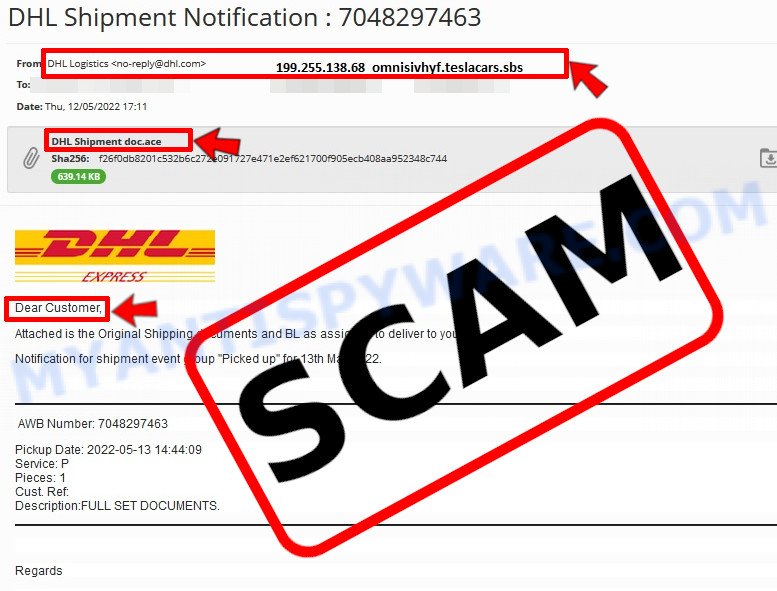
Here are some ways to recognize a phishing email
- Inconsistencies in Email Addresses. The most obvious way how to spot a scam email is finding inconsistencies in email addresses and domain names. If the email claims to be from a reputable company, like Amazon or PayPal, but the email is being sent from a public email domain, such as “gmail.com” it’s probably a scam.
- The domain name is misspelt. Look carefully for any subtle misspellings in the domain name. Like arnazon.com where the “m” has been replaced by “rn”, or paypa1.com, where the “l” has been replaced by “1”. These are common tricks of scammers.
- Generic greetings. If the email starts with a generic “Dear”, “Dear sir” or “Dear madam” that is a warning sign that it might not really be your shopping site or bank.
- Suspicious links. If you have the slightest suspicion an email may be a scam, do not click on the links you see. Instead, hover over the link, but don’t click it. This will pop up a small box that contains the actual URL. This works on image links as well as text links.
- Unexpected attachments. Email attachments should always be verified before clicking. Any attachments should be scanned for viruses – especially if they have an unfamiliar extension or one commonly associated with malware (.zip, .exe, .scr, etc.).
- The email creates a sense of urgency. Creating a false sense of urgency is a common trick of phishing emails. Be suspicious of emails that claim you must call, open an attachment or click a link immediately.
Report Scam Email
If you receive a scam email that is similar but not the same as the example above, make sure you remove any personal info in this message, then post it as comment on this article. This helps us to warn users about current scams, monitor trends and disrupt scams where possible.
